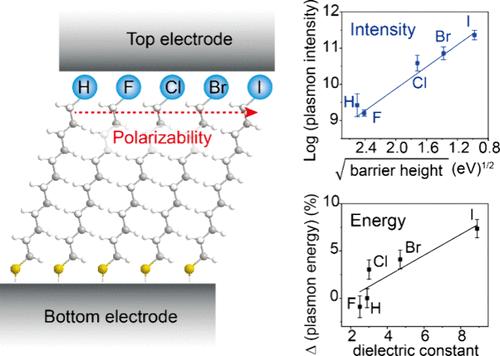当前位置:
X-MOL 学术
›
J. Am. Chem. Soc.
›
论文详情
Our official English website, www.x-mol.net, welcomes your
feedback! (Note: you will need to create a separate account there.)
Tuning Overbias Plasmon Energy and Intensity in Molecular Plasmonic Tunneling Junctions by Atomic Polarizability
Journal of the American Chemical Society ( IF 14.4 ) Pub Date : 2024-06-28 , DOI: 10.1021/jacs.4c05544 Wei Du 1 , Xiaoping Chen 1, 2 , Tao Wang 1 , Qianqi Lin 3 , Christian A Nijhuis 3
Journal of the American Chemical Society ( IF 14.4 ) Pub Date : 2024-06-28 , DOI: 10.1021/jacs.4c05544 Wei Du 1 , Xiaoping Chen 1, 2 , Tao Wang 1 , Qianqi Lin 3 , Christian A Nijhuis 3
Affiliation

|
Plasmon excitation in molecular tunnel junctions is interesting because the plasmonic properties of the device can be, in principle, controlled by varying the chemical structure of the molecules. The plasmon energy of the excited plasmons usually follows the quantum cutoff law, but frequently overbias plasmon energy has been observed, which can be explained by quantum shot noise, multielectron processes, or hot carrier models. So far, clear correlations between molecular structure and the plasmon energy have not been reported. Here, we introduce halogenated molecules (HS(CH2)12X, with X = H, F, Cl, Br, or I) with polarizable terminal atoms as the tunnel barriers and demonstrate molecular control over both the excited plasmon intensity and energy for a given applied voltage. As the polarizability of the terminal atom increases, the tunnel barrier height decreases, resulting in an increase in the tunneling current and the plasmon intensity without changing the tunneling barrier width. We also show that the plasmon energy is controlled by the electrostatic potential drop at the molecule–electrode interface, which depends on the polarizability of the terminal atom and the metal electrode material (Ag, Au, or Pt). Our results give new insights in the relation between molecular structure, electronic structure of the molecular junction, and the plasmonic properties which are important for the development of molecular scale plasmonic-electronic devices.
中文翻译:

通过原子极化率调节分子等离激元隧道结中的过偏等离激元能量和强度
分子隧道结中的等离子体激发很有趣,因为原则上可以通过改变分子的化学结构来控制器件的等离子体特性。激发的等离激元的等离激元能量通常遵循量子截止定律,但经常观察到过偏等离激元能量,这可以通过量子散粒噪声、多电子过程或热载流子模型来解释。迄今为止,分子结构与等离激元能量之间的明确相关性尚未见报道。在这里,我们引入了具有可极化末端原子的卤化分子(HS(CH 2 ) 12 X,其中X = H、F、Cl、Br或I)作为隧道势垒,并证明了分子对激发等离子体激元强度和能量的控制给定的施加电压。随着末端原子极化率的增加,隧道势垒高度降低,导致隧道电流和等离子体激元强度增加,而隧道势垒宽度不改变。我们还表明,等离激元能量由分子-电极界面处的静电势降控制,这取决于末端原子和金属电极材料(Ag、Au 或 Pt)的极化率。我们的研究结果为分子结构、分子结的电子结构和等离子体特性之间的关系提供了新的见解,这对于分子尺度等离子体电子器件的发展非常重要。
更新日期:2024-06-28
中文翻译:

通过原子极化率调节分子等离激元隧道结中的过偏等离激元能量和强度
分子隧道结中的等离子体激发很有趣,因为原则上可以通过改变分子的化学结构来控制器件的等离子体特性。激发的等离激元的等离激元能量通常遵循量子截止定律,但经常观察到过偏等离激元能量,这可以通过量子散粒噪声、多电子过程或热载流子模型来解释。迄今为止,分子结构与等离激元能量之间的明确相关性尚未见报道。在这里,我们引入了具有可极化末端原子的卤化分子(HS(CH 2 ) 12 X,其中X = H、F、Cl、Br或I)作为隧道势垒,并证明了分子对激发等离子体激元强度和能量的控制给定的施加电压。随着末端原子极化率的增加,隧道势垒高度降低,导致隧道电流和等离子体激元强度增加,而隧道势垒宽度不改变。我们还表明,等离激元能量由分子-电极界面处的静电势降控制,这取决于末端原子和金属电极材料(Ag、Au 或 Pt)的极化率。我们的研究结果为分子结构、分子结的电子结构和等离子体特性之间的关系提供了新的见解,这对于分子尺度等离子体电子器件的发展非常重要。











































 京公网安备 11010802027423号
京公网安备 11010802027423号